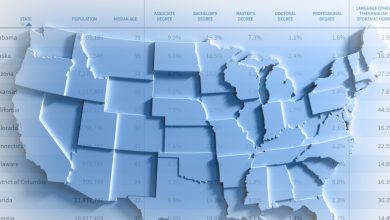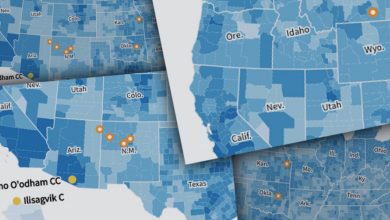Millions of Students a Year Are Required to Buy Courseware. Often, It Replaces the Professor.

[ad_1]
This is Part 1 of a three-part series on the use of courseware at colleges. Parts 2 and 3, which will focus on cost and data privacy, will publish July 19 and 20.
The recent graduate of Oakland University, in Michigan, would submit his assignments and exams online for the introductory, asynchronous course, which had at least 100 students. Everything, including his final exam, was auto-graded. It all made for an underwhelming, and often frustrating, learning experience.
“There were never ways we could learn from the instructor,” said Romano, who double-majored in political science and environmental science. “It was just a really weird class.”
Romano’s instructor was using a courseware product from the publishing titan Cengage. In a departure from traditional supplementary class materials, like textbooks, many courseware tools offer the “soup to nuts” of an entire course: Not only the digital version of a textbook, but homework assignments and assessments that an instructor can select from a bank of premade options. Educational videos, slide presentations, and study flashcards. Auto-grading and performance-analytics capabilities.
These products often can’t be unbundled, so while students purchase the whole slate, faculty members decide how little — or how much — of the courseware services to use.
While such products rarely come up in the public discourse about higher education, they’ve become a staple across in-person, hybrid, and virtual college classrooms alike. About one-third of faculty members who responded to the 2022 Faculty Watch survey from the National Association of College Stores reported using “access codes and adaptive learning products,” terms commonly associated with leading courseware products like MindTap (Cengage), Connect (from McGraw Hill), and MyLab (from Pearson) — a figure that has gradually increased since the first survey in 2016.
Millions of students use these tools every year. McGraw Hill, for example, reported 5.2 million activations of its Connect product alone in the United States in the 2023 fiscal year. A Chronicle review of an online database curated by Don McIntosh, an online-learning expert, found more than 20 vendors in the U.S. higher-ed market offering similar products.
Some faculty members believe these tools, which can provide students with immediate feedback and additional practice, help them learn. But skeptics fear misuse or poor execution. Instructors often buy the tools directly from publishers, with limited oversight from administrators, because their choices are considered covered by academic freedom. Many instructors’ introduction to courseware also came during the pandemic, when the products may have been hastily adopted as a survival mechanism, without training or guidance on how to use them to supplement — not supplant — their own teaching.
While most faculty members are not using courseware to replace instruction, numerous sources acknowledged that some are essentially running classes on autopilot, with courseware doing the work that students, and federal law, expect instructors to do.
Administrators like Chris Hubbard-Jackson have seen both ends of the spectrum, and a myriad of configurations in between.
Courseware can be an “absolutely amazing” addition to a class when instructors use it appropriately, said Hubbard-Jackson, the dean of assessment and institutional effectiveness at St. Charles Community College, in Missouri. “It depends on how the specific instructor is using it.” Unfortunately, she said, she’s heard of faculty “who use the set-it-and-forget-it method,” too.
For some, outsourcing tasks like homework and grading means quicker feedback for students, and more time to focus on teaching or research. Other adopters may be underpaid and under-resourced instructors, including part-time adjuncts, who got their class schedule a mere week in advance, or who generally don’t have the time or mentorship needed to develop their own materials and course designs.
“There are so many different demands” on faculty, “that if a publisher says, ‘Here’s a textbook — oh, and it comes with all of this stuff,’” that’s going to sound appealing, said Julia Rodriguez, an associate professor and scholarly communications librarian at Oakland University who, as a textbook-affordability expert, is familiar with courseware. “It’s like getting a five-course meal.”
Faculty members are inundated, too, with messages from publishers marketing these tools as “the next best thing to sliced bread,” as Barbara Taylor, director of academic technology at California State University at San Marcos, puts it. They may entice instructors with free demonstrations, or dangle an Amazon gift card in return for completing a survey about their class needs. Sometimes publisher representatives walk the hallways and offer trainings. The outreach, numerous faculty members told The Chronicle, can be quite aggressive.

Sam Green for The Chronicle
“I get stuff daily, from multiple publishers,” wrote Matthew Regele, an assistant professor of management and entrepreneurship at Xavier University, in Ohio, in an email. “I should probably try to unsubscribe.”
Representatives for the three major publishers said their marketing strategy isn’t to push particular products unprompted. Rather, outreach is meant to start a conversation about the tools a faculty member is already using, whether they’re working, and what solutions may exist. Speaking to the broader complaints of aggressive marketing, Kent Peterson, senior vice president and chief marketing officer for McGraw Hill’s higher-education business, said that faculty members can specify the types of emails they wish to receive, and that the company aims to make emails “very informative, very quick.”
Still, he acknowledged, “It’s a valid criticism.”
While it’s difficult to make definitive statements about which types of faculty members end up adopting courseware, existing research and anecdotes from publishers suggest higher usage in lower-level, high-enrollment courses, and in more quantitative STEM subjects. Adoption, to note, is not always the faculty member’s choice; in many lower-level courses, instructors are required — or encouraged — to use a predetermined courseware product to maintain consistency across sections.
For example, like many of her colleagues, KaSai Un, an assistant mathematics professor at Texas A&M University at Commerce who teaches both in-person and online courses, uses Pearson’s MyLab for the eBook, homework, and quizzes. The department wants instructors who teach first-year math courses, like college algebra, to give students “the same experience,” she said, and to minimize headaches that might come with having to navigate multiple publisher tools.
Others adopt courseware for individual, pedagogical reasons. Lauryn De George, a senior instructor in the University of Central Florida’s College of Business, turned to Cengage’s MindTap a few years ago to help wrangle her management course, which serves some 1,200 students across six hybrid sections. She uses MindTap for textbook readings, homework assignments with auto-grading, study flashcards, educational videos, and sample exam questions — all resources that she said facilitate student work, study, and practice outside the classroom. That way, the face-to-face portion of her class can be more of a “flipped” model, dedicated to small-group activities and assessments.
This approach, she said, creates “scalable intimacy” in what otherwise might be an unwieldy, impersonal course.
But Rodriguez, at Oakland, is not sold. While she said she’s not “so naïve that I think we won’t need to rely on publishers for some course content,” she still sees “offloading students and teaching to a for-profit company” as a problem. Among other things, she said it risks diluting the uniqueness of an institution’s educational experience and degree offerings.
And in cases where a course operates fully online, legal risks come into play, too.
For distance-education courses and programs that are eligible for Title IV aid (as the majority are), federal law requires “regular and substantive interaction,” or RSI, between instructors and their students. To meet that requirement, an instructor must provide at least two of five “substantive” activities, such as “direct instruction” and “facilitating a group discussion.” Opportunities for such interaction must also occur “on a predictable and scheduled basis.”
The law’s language is a bit vague, allowing flexibility. It has to when “you’re trying to apply a single standard to 6,000 institutions of higher education that are designed in different ways,” with unique objectives and student bodies, said Aaron Lacey, a partner at Thompson Coburn LLP who chairs the law firm’s higher-education practice.
That makes RSI admittedly tricky to enforce — especially at the accreditor level. Education Department regulations for accreditors make no mention of evaluating institutions for RSI, said Leah Matthews, executive director of the Distance Education Accrediting Commission. “A lot of institutions,” she said, “are getting a pass.”
But that doesn’t mean they should be complacent. If noncompliance is found, “the liability to an institution could be significant,” Lacey said. “It’s a pay-it-all-back liability.”
I would rather have my instructors teach me with their own material, with assignments they’ve made themselves.
The frustration is palpable on platforms like Reddit, where users anonymously congregate to commiserate on the trials and tribulations of higher education. “If you want to learn it does really suck,” one wrote. Others summed up their experiences with courseware tools as “absolute bullshit” and “lazy.”
One such user was Bethany Lewis, a sophomore at Rogue Community College, in Oregon, who took two online computer-science courses using MindTap in the spring of 2022. The classes felt disjointed, she said; the questions that followed assigned activities would focus on “little details” rather than driving home key concepts, and they didn’t seem to align with the promised learning outcomes in her professors’ syllabi. There were often distracting typos as well that further reminded her the materials weren’t coming from her instructor.
As someone paying for an education, “I would rather have my instructors teach me with their own material, with assignments they’ve made themselves,” Lewis wrote in an email.
Lewis ended up switching majors from computer science to psychology. She readily admits that math isn’t her strong suit — a natural strike against pursuing a STEM major, perhaps — but she said her negative experience in those courses played a role. (Asked whether such critiques were on Cengage’s radar, a spokesperson wrote in an email that “we continually refine our platforms based on customer input.”)
Courseware is not designed to replace the faculty and student relationship.
Phil Swanson, a student on hiatus from the University of Illinois Urbana-Champaign, was also frustrated with what he called “kind of useless” assignments and quizzes that he’d take through McGraw Hill Connect for his online synchronous course in public speaking in the fall of 2020.
Public speaking is largely skills-based, he said — yet he estimated some 30 percent of his course grade hinged on answering multiple-choice questions. He referred The Chronicle to a post he’d written on Reddit around that time, where he’d recalled one question along the lines of: What’s a good way to look confident? A. Slouching. B. Not looking at the audience. C. Standing up straight. D. Reading from a notebook.
“It’s a way to teach,” he said. “But definitely not the best, in my opinion.”
Asked about some students’ lackluster experiences with courseware, publishers responded that everything depends on how an instructor implements the products. David Duke, chief product officer for McGraw Hill’s higher-education business, pointed to elements of Connect — like SmartBook 2.0, a reading tool with adaptive-learning capabilities, and student-polling features — that can foster a more-personalized user experience with regular instructor interactions.
“Courseware is not designed to replace the faculty and student relationship,” Duke said. “The exact opposite. It’s meant to enrich faculty-student interactions by providing more time to interact” during class, “and more information to deepen those interactions.” Asked how that would work for online asynchronous courses, he replied that fostering an interactive experience is up to the university and the faculty member.
The spokesperson for Cengage expressed a similar sentiment, writing that instructors who use MindTap can customize content in various ways, such as editing existing assessments, embedding their own assessments, and reordering or removing textbook chapters. (Cengage declined an interview with The Chronicle after the reporter shared questions, and opted for written responses.)
For Kate Edwards, senior vice president for efficacy and learning at Pearson, the pandemic’s role can’t be ignored. “We have lived through some quite distinctive world events that I think have caused what you may describe as a ‘rush’ to online,” thus hampering the ability in many cases for instructors to experiment and be thoughtful, she said. Pearson has been developing educator guides, she added, “that begin to crystalize best practices.”
Feedback from students is not all negative. The online-homework component, especially, can be popular. In a 2022 “Lifestyle & Media” report from the research service Student Monitor, 69 percent of respondents said the function was “valuable” for getting instant feedback on quizzes, while 63 percent said it made it easier for them to track their progress.
Jackie Carrasco, a pre-med student at Wayne State University, in Detroit, is one learner who feels she’s benefited from courseware. The homework questions for her organic-chemistry class, which used another Cengage courseware tool called OWLv2, included questions likely to appear on the Medical College Admission Test (MCAT) — something she saw as a meaningful way “to prepare us for the long run.”
If they make it easier to get the grade, that doesn’t mean you’re learning more, necessarily.
Many employees at the company where Regele worked, he wrote, held a “narrow” definition of what student learning and success meant: the obtainment of a credential — namely, a diploma — and higher grades. That, he found, influenced the design of the courseware, including functions such as multiple or unlimited attempts on assignments.
Indicators like grades, he emphasized, are not inherently flawed. But they can be. “If they make it easier to get the grade, that doesn’t mean you’re learning more, necessarily,” he told The Chronicle. (The multiple-attempts model does have some proponents, with a 2018 study linking the model to increased student learning.)
Ensuring that students actually learned the material and concepts didn’t seem like a priority, either. He wrote in his paper that a software-development manager once told him: “There are the instructors who are really caring for the students to learn, and they want to impart all this knowledge. Those ones I find are a bit more hesitant” to adopt these products.
Regele doesn’t entirely blame the publishers. “I don’t think a lot of the people involved are intentionally trying to do things that might not be good for education,” he said. “But they do have their own goals and interests” that can fall out of alignment with those of higher education.
Publishers told The Chronicle that higher-education expertise is baked into their courseware products. Edwards at Pearson, for example, said that creating a product like MyLab involves a group effort — taking authors who are leaders in their field and bringing them together with instructional and learning designers “who are experts in the science of how students learn,” along with other necessary specialists in content development, product management, and technology.
Duke, at McGraw Hill, added that the company is continuously engaging with faculty to get feedback on its products, including through surveys, symposiums, and sales-team outreach. The spokesperson for Cengage underscored the importance of a feedback loop, noting that it seeks input from students, too.
Even so, academics skeptical of the expansive use of courseware are eager to see data: Do these tools really support student learning?
For now, at least, that question is impossible to answer definitively. In speaking with numerous sources, The Chronicle was unable to identify wholly independent and scaled research that answers that question.
The dearth is, perhaps, not entirely surprising. Courseware is defined in different ways by different people. Instructors don’t all use the same courseware components in class. Students’ goals for learning may vary. So comparisons are tricky.
There are elements of some courseware — such as adaptive learning, in which lessons and activities are adjusted in real time for individual learners depending on how they’re performing — that have shown promise. Pearson told The Chronicle it’s continuing to work with independent third parties to conduct and publish research on the efficacy of products like MyLab. Publishers pointed to their case studies, as well, which often highlight individual instructors’ experiences with their courseware tools.
Still, those metrics are imperfect. Some case studies found online are more than a decade old, and many tend to be more anecdotal than evidence-based, elevating the risk of overstated claims. (For example, De George, the professor at UCF, is highlighted in a Cengage case study titled “Engagement and Grades Increase ‘Dramatically’ in 1,200+ Student Class.” The Chronicle asked Cengage for the data buttressing that case study’s claims, but the company did not provide a response.)
Stacey Margarita Johnson, who until recently taught introductory Spanish and served as assistant director of educational technology at Vanderbilt University, said she never left it up to courseware to teach her students. Johnson had to use MindTap for class; department policy requires all instructors teaching first-year Spanish courses — some 20 sections a semester, according to a search of the campus bookstore site — to use the same courseware product. But she made the most of it, drawing from the more than 20 years of teaching experience under her belt.
She’d add her own activities. She’d explain the logic behind the MindTap assignments — you’ll be drilling verb conjugations this week because we’re going to practice speaking next week — so students didn’t see them as pointless “busy work.” Johnson, who’s now the director of learning and engagement at the Coalition of Urban and Metropolitan Universities, also shared stories of other faculty members citing research for students on why certain skills are important, or doing the publisher assignments themselves first to gauge the time commitment and applicability to the learning goals they have for their students.
Wherever possible, faculty members should “still be the leaders of their own course design, their own facilitation practices,” she said.
At Oakland University, where Romano took his physics course, faculty members “have complete autonomy” over class materials, including courseware, and they can add any tool they want directly into the learning-management system, said Dan Arnold, manager of support services. A spokesperson for Saddleback College, in California, whose international-languages department uses Connect extensively, also stated that there is no approval process for using courseware; the college “allows each instructor the academic freedom to select their own textbooks and/or materials for their courses.” (The one exception, she wrote, is for Spanish 1 and 2 courses, where Connect is used universally.)
Some institutions and their departments, though, are trying to strike a balance — preserving academic freedom while encouraging thoughtfulness about ed-tech adoption and usage.
Un, the assistant math professor at Texas A&M-Commerce, wrote in an email that first-year math faculty generally agree on the textbook they’re going to adopt before discussing courseware — a practice that helps keep the focus on whether the material and lessons “fit our needs,” rather than on the array of additional product services.
At Carnegie Mellon University, staffers in the Eberly Center for Teaching Excellence and Educational Innovation also encourage faculty members to work with them on “tool matching” before selecting materials like courseware. In this process, instructional designers learn about the course and its learning objectives, and advise faculty members accordingly.
“Let’s say there is some courseware that has lots of multiple-choice questions. … But the faculty member wants students to be able to apply concepts and solve problems. That would not be a good match,” said Marsha Lovett, vice provost for teaching and learning innovation at Carnegie Mellon. The guiding question is often: “Does this tool have a lot of the features and qualities that we would expect would be consistent with positive learning outcomes?”
The question of academic value is one that accrediting agencies certainly care about, too. But their level of awareness around courseware is also patchy.
The Chronicle reached out to the seven main U.S. accrediting agencies, asking if any of their institutional-review processes — such as those for accreditation renewal — include elements where courseware use would come up.
Sonny Ramaswamy, president of the Northwest Commission on Colleges and Universities, doubted it would. “Our Standards are not prescriptive on courseware, technologies, etc.,” he wrote in an email. “They focus instead on data-informed outcomes for students, particularly student success and closing equity gaps.”
Other agencies, like the Middle States Commission on Higher Education, shared standards that — while not mentioning courseware by name — could encourage proper use. MSCHE’s standards, for example, say institutions must demonstrate “student learning experiences that are designed, delivered, and assessed by faculty.”
Matthews, with the Distance Education Accrediting Commission, said her agency focuses intently on regular and substantive interaction. When it’s conducting curriculum reviews during the accreditation-renewal process for a Title IV-participating institution, for example, at least one of the subject specialists charged with sampling 25 to 50 percent of the courses is checking for evidence of RSI. In these course-level reviews, they’re able to see the tools faculty are using, including courseware products.
Still, a lot of this comes down to goodwill. “There is a level of trust and accountability and integrity that in between your accreditation cycles, you are upholding the requirements,” Matthews said.
An Education Department spokesperson said the department looks for observance of RSI when it reviews institutions’ annual Title-IV compliance and financial audits. Staff members conduct occasional program reviews as well.
It’s also seeking to extend its oversight of some ed-tech providers, which could include publishers. Pending guidance may place such companies under a “third-party servicer” designation, subjecting them to certain legal liabilities and regulatory requirements, such as annual audits. The department confirmed that an entity can be considered a third-party servicer whether it’s working with an entire institution or one individual.
Even if publishers come away from these developments unscathed, advocates have another bone to pick with the courseware they sell: the often-high price.
And the fact that students must pay it.
On Wednesday, Part 2: “The Homework Tax”
[ad_2]
Source link






